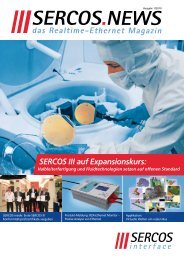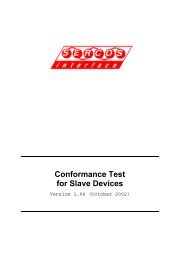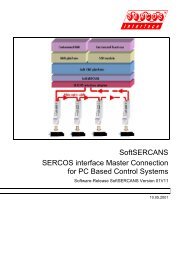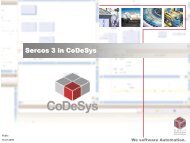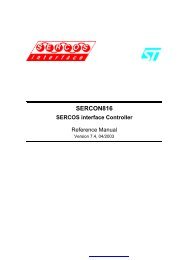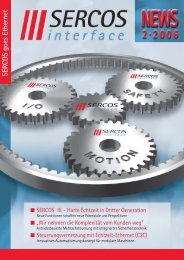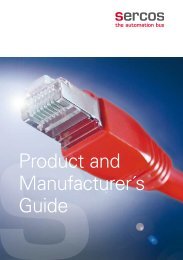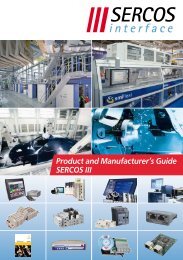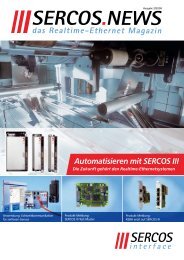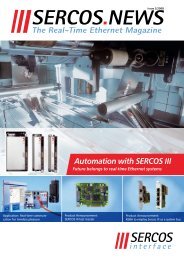SERCOS News - Issue 1 - 2008
SERCOS News - Issue 1 - 2008
SERCOS News - Issue 1 - 2008
Create successful ePaper yourself
Turn your PDF publications into a flip-book with our unique Google optimized e-Paper software.
6 Sercos-Inside<br />
The Real-Time Ethernet Magazine<br />
Standard ethernet componets - save costs<br />
and simplifies systemarchitecture<br />
out long lead times. In practice, however,<br />
a modern network is expected to<br />
be able to do even more than this. Flexibility<br />
also means being able to combine<br />
individual modules to form new solutions<br />
at low cost. Intelligent control<br />
systems turn machines into reusable<br />
modular systems, the components of<br />
which can be combined anew as requirements<br />
dictate. The network therefore<br />
has to be highly flexible. As a general<br />
rule individual components (slaves) are<br />
controlled by a controller (master). This<br />
results in the typical linear bus structure<br />
of a section of production. In turn, the<br />
individual controllers can communicate<br />
with each other via a joint network, or<br />
gateway, segment.<br />
As well makes it possible for data to<br />
be exchanged directly between a sensor<br />
and a drive which are controlled by<br />
separate controllers. This reduces the<br />
load on the central control system and<br />
also cuts data flows in the network. This<br />
so-called C2C (control-to-control) crosscommunication<br />
between masters, such<br />
as two PLCs, for example, provides the<br />
basis for the distributed control of complex<br />
production lines. This flexibility in<br />
communication, which leads to reduced<br />
reaction times between master or slave<br />
devices and, therefore, in the overall<br />
process, permits the synchronous actuation<br />
of axes at any time, even where<br />
several <strong>SERCOS</strong> networks are involved.<br />
The technology which makes crosscommunication<br />
between the individual<br />
nodes possible not only contributes to<br />
the efficiency and flexibility of <strong>SERCOS</strong><br />
solutions, it also increases safety because<br />
it enables a <strong>SERCOS</strong> III network<br />
to be organized on the basis of a ring<br />
structure. In the event of a cable failure,<br />
therefore, a redundant signal route is<br />
available. This is not the case in the classical<br />
Ethernet which uses switches and<br />
routers for coordinating data flows. The<br />
<strong>SERCOS</strong> network, in contrast, coordinates<br />
itself and offers flexible strategies:<br />
a classical linear structure in order<br />
to save materials or a redundant ring<br />
structure for greater safety. The engineers<br />
have the choice of selecting the<br />
most suitable cabling to meet requirements<br />
without having to think about<br />
additional elements for the network<br />
infrastructure.<br />
The same applies to the safety of data<br />
transmission. <strong>SERCOS</strong> offers a certified<br />
safety protocol as standard to ensure<br />
that information is safely transferred.<br />
<strong>SERCOS</strong> safety complies with the requirements<br />
of safety standard IEC 61508 up<br />
to Safety Integrity Level 3 (SIL 3). This<br />
covers risks arising out of or in connection<br />
with system failures and which may<br />
netX 50<br />
netX 50 – networX on Chip<br />
• 16 or 32 bit network controller with two<br />
communication channels for field bus or real-time<br />
Ethernet with integrated PHY / Switch / Hub<br />
• EtherCAT with 8 FMMUs / Sync-Manager<br />
and 6 KB IO data<br />
• Controller for IO-Link master and CCD sensor<br />
• Hardware platform for IOs and IO-Link gateways



